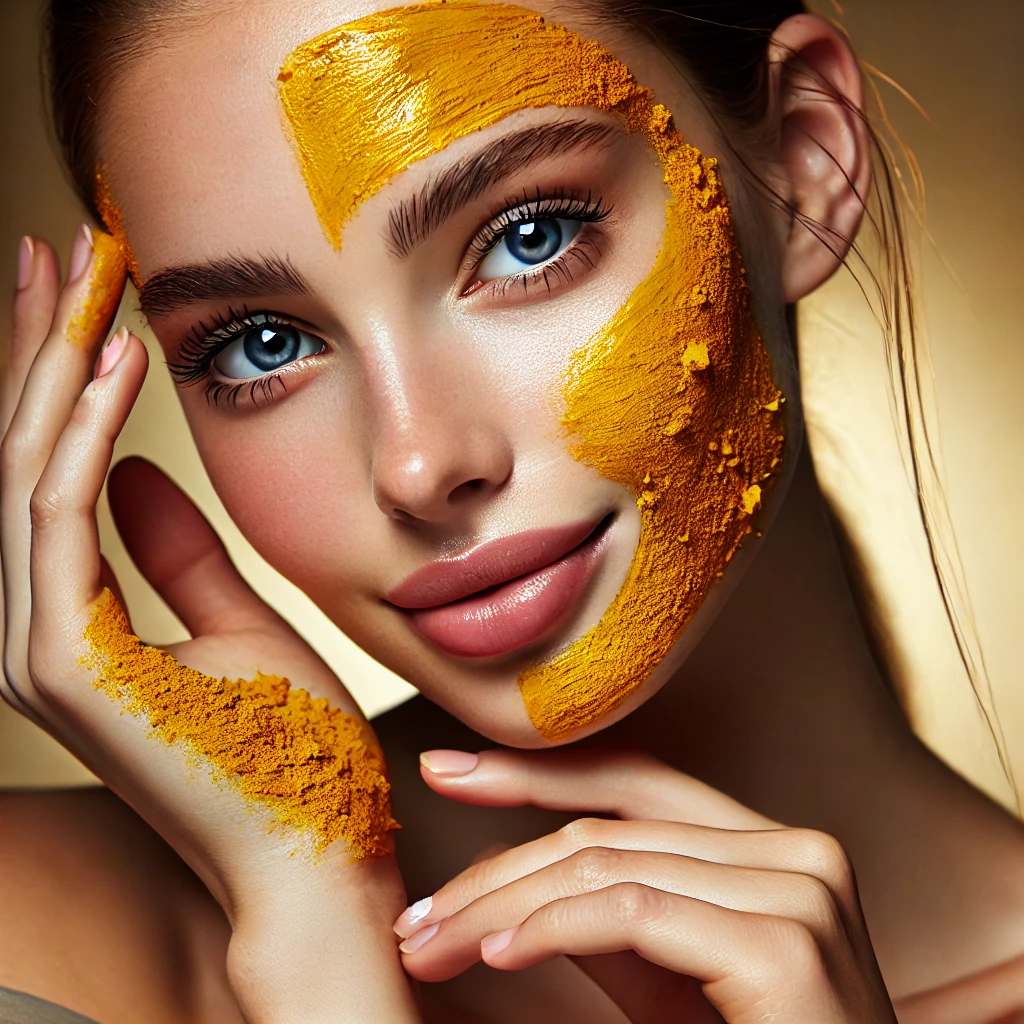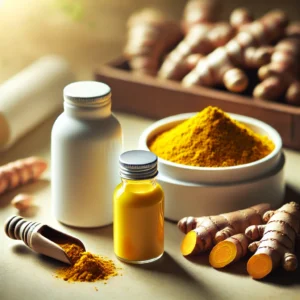1. Turmeric Reduces Inflammation and Soothes Skin
One of the most significant benefits of turmeric for skin is its ability to reduce inflammation. The active compound curcumin has potent anti-inflammatory properties that can help calm irritated skin and reduce redness. Whether you’re dealing with acne, eczema, or general skin irritation, turmeric can work wonders in providing relief.
How does turmeric help?
-
Anti-inflammatory properties: Curcumin blocks certain molecules that play a key role in promoting inflammation.
-
Reduces redness: By calming the skin, turmeric can reduce the appearance of redness and swelling, making it a great remedy for conditions like acne, rosacea, and allergic reactions.
-
Soothing effects: It helps to cool down the skin, providing immediate comfort to stressed and inflamed skin.
How to Use It
To benefit from turmeric’s anti-inflammatory properties, you can make a turmeric paste by mixing turmeric powder with yogurt, honey, or milk. Apply this mixture to affected areas of your skin and leave it on for 15-20 minutes before rinsing off with warm water. Regular application can help to reduce inflammation over time.
2. Turmeric Brightens and Evens Out Skin Tone
Another incredible benefit of turmeric is its ability to brighten the skin and even out skin tone. Whether you’re dealing with dark spots, hyperpigmentation, or uneven complexion, turmeric’s natural bleaching properties can help lighten and brighten the skin.
How does turmeric brighten skin?
-
Reduces dark spots: The curcumin in turmeric inhibits the production of melanin, the pigment responsible for dark spots, and hyperpigmentation.
-
Glowing skin: Regular use of turmeric can help the skin look more radiant by reducing the appearance of blemishes and imperfections.
-
Even skin tone: Turmeric helps to promote an even and uniform skin tone, reducing the look of age spots and sunspots.
How to Use It
To create a brightening mask, mix turmeric powder with lemon juice and honey. This combination is rich in antioxidants and helps lighten pigmentation. Apply it to your face and leave it on for 10-15 minutes, ensuring not to leave it too long as turmeric can stain your skin. Rinse thoroughly to reveal a brighter complexion.
3. Turmeric Helps Fight Acne and Prevent Breakouts
For those with acne-prone skin, turmeric can be a game-changer. Turmeric’s antibacterial and anti-inflammatory properties make it an effective remedy to prevent acne and reduce existing breakouts. It helps kill the bacteria that contribute to acne formation while reducing swelling and redness associated with pimples.
How does turmeric fight acne?
-
Antibacterial: Turmeric has strong antibacterial properties, which help in killing the acne-causing bacteria on the skin.
-
Reduces acne scars: Curcumin is also known to reduce the appearance of scars left by acne, helping to speed up the healing process.
-
Controls oil production: Excess oil on the skin can clog pores and cause acne. Turmeric can help regulate the production of sebum, thereby reducing acne breakouts.
How to Use It
For acne-prone skin, create a turmeric face mask by mixing turmeric powder with neem oil or tea tree oil, both of which have antibacterial properties. Apply this paste directly to your acne and leave it on for 15 minutes before rinsing off. It will help fight bacteria, reduce inflammation, and heal your skin.
4. Turmeric Reduces the Appearance of Wrinkles and Fine Lines
Turmeric is not just for treating acne or irritation—its antioxidant properties can also help combat the signs of aging. By neutralizing free radicals that damage skin cells, turmeric helps maintain the skin’s youthful appearance by preventing the breakdown of collagen, a protein responsible for skin elasticity.
How does turmeric help with wrinkles?
-
Anti-aging properties: Curcumin boosts collagen production and helps maintain the skin’s firmness, reducing the appearance of fine lines and wrinkles.
-
Protects against sun damage: Sun exposure can accelerate the formation of wrinkles. Turmeric helps protect the skin from the harmful effects of UV rays.
-
Promotes skin regeneration: Turmeric stimulates the regeneration of skin cells, which helps in reducing the signs of aging and promoting smoother skin.
How to Use It
To reduce wrinkles and fine lines, you can create a simple anti-aging face mask by mixing turmeric powder with aloe vera gel and coconut oil. This combination of ingredients will hydrate the skin while also providing anti-aging benefits. Apply it to your face and leave it on for 20 minutes, then rinse off.
5. Turmeric Helps in Healing Skin Damage and Scars
Turmeric’s healing properties are widely celebrated. It promotes skin regeneration and can help heal wounds and scars, whether from cuts, burns, or post-surgical scars. The antioxidant-rich nature of turmeric aids in the repair and renewal of skin cells, making it an excellent choice for treating damaged skin.
How does turmeric promote healing?
-
Wound healing: The anti-inflammatory and antioxidant effects of turmeric can speed up the healing of wounds, burns, and cuts.
-
Reduces scarring: Turmeric helps to minimize the formation of scars by promoting tissue regeneration and reducing inflammation around the wound.
-
Improves skin elasticity: By stimulating collagen production, turmeric helps improve the skin’s elasticity, allowing it to repair itself more efficiently.
How to Use It
To use turmeric for healing scars, mix turmeric powder with raw honey and apply the paste to the affected area. Honey has natural healing properties that complement turmeric’s effectiveness in healing and regenerating skin cells. Apply this mask once a day until you see noticeable improvement in your scars.
Conclusion
Incorporating turmeric into your skincare routine offers a myriad of benefits, from reducing inflammation and acne to promoting a brighter and more even complexion. With its potent anti-inflammatory, antibacterial, and antioxidant properties, turmeric has the potential to address many common skin issues. Whether you’re looking to fight acne, reduce the signs of aging, or heal scars, turmeric can be a powerful, natural addition to your skincare regimen.
However, it’s important to remember that turmeric can stain the skin, so always rinse thoroughly after application. To avoid skin irritation, perform a patch test before using turmeric on larger areas. Additionally, the best results are achieved through consistent use, so be patient as you incorporate this golden spice into your daily skincare routine.
FAQs
Does turmeric brighten skin immediately?
No, turmeric works gradually to brighten skin. It helps reduce pigmentation over time and promotes a glowing, even complexion with consistent use.
Can turmeric be used for all skin types?
Yes, turmeric is generally safe for all skin types. However, individuals with sensitive skin should do a patch test before using it regularly.
Is turmeric effective for dark circles?
Yes, turmeric can reduce the appearance of dark circles due to its anti-inflammatory and brightening properties.
How often should I use turmeric on my skin?
For best results, apply turmeric-based masks or treatments 2-3 times a week. Regular use will help maintain healthy and radiant skin.
Can turmeric help with sunburn?
Yes, turmeric’s anti-inflammatory properties can help soothe and heal sunburned skin. It also helps in reducing redness and promoting skin repair.
Does turmeric help with skin aging?
Yes, turmeric’s antioxidant properties can slow the signs of aging, reduce wrinkles, and promote collagen production, making it an excellent anti-aging ingredient.

